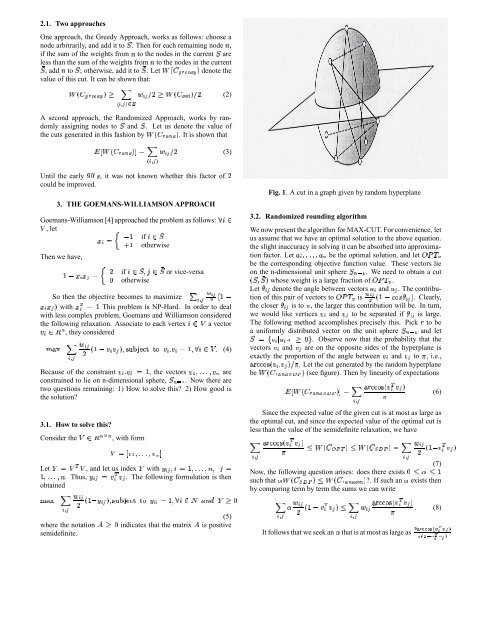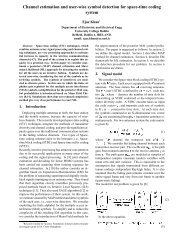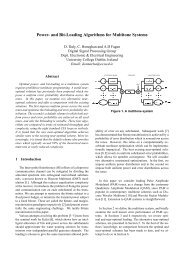Maximum likelihood detection of MIMO system using second order ...
Maximum likelihood detection of MIMO system using second order ...
Maximum likelihood detection of MIMO system using second order ...
You also want an ePaper? Increase the reach of your titles
YUMPU automatically turns print PDFs into web optimized ePapers that Google loves.
AV- A: - ; 7790¡QWWW- A: - ; 7790¡QJ)ZJ ' Z)2.1. Two approachesOne approach, the Greedy Approach, works as follows: choose anode arbitrarily, and add to> it . Then for each node£remaining ,if the sum <strong>of</strong> the from£weights to the nodes in current> the areless than the sum <strong>of</strong> the from£weights to the nodes in the current, add£to> ; otherwise, add it to A > . LetE ¡¡ £¢¥¤¦¤¨§£©denote thevalue <strong>of</strong> this cut. It can be shown that:> E ¡ FIH"J (2)E ¡ ¢¥¤¦¤¨§£©A <strong>second</strong> approach, the Randomized Approach, works by>ran-. Let us denote the value <strong>of</strong>Z*[] 9 :;X:\Y;domly assigning nodes > to A andthe cuts generated in this fashion byE ¡¢§. It is shown that-E ¡ ¢¥§' VX:\Y; Z 9d:; (3)Until the early ef¤$ , it was not known whether this factor <strong>of</strong> could be improved.3. THE GOEMANS-WILLIAMSON APPROACHGoemans-Williamson [4] approached the problem as +=# A > or vice-versa otherwise1So then the objective becomes to $ :\Y;&%('*) +¡ 1 Cmaximizewith less complex problem, Goemans and Williamson consideredthe following relaxation. Associate to each vertex A&I ¡ 1CON£P$M:; to is . Clearly,M:; the closer Q is to , the larger this contribution will be. In turn,we would like : vertices and ; to be separated if M :; is large.The following method accomplishes precisely this. Pick - to be- Ra uniformly distributed vector on the unit sphere > 5< :and let0 - : 7 F : R 5. Observe now that the probability that thevectors - : and - ; are on the opposite sides <strong>of</strong> the hyperplane is>('exactly the proportion <strong>of</strong> the angle between : and - ; to Q , i.e.,7790%¡ - - - ; Q . Let the cut generated by the random hyperplanebeE ¡ ¢§ P5TU(see figure). Then by linearity <strong>of</strong> expectations:MSSince the expected value <strong>of</strong> the given cut is at most as large asthe optimal cut, and since the expected value <strong>of</strong> the optimal cut isless than the value <strong>of</strong> the semidefinite relaxation, we have-E ¡ ¢§ P5TU' V:¤Y;MS(6)' -;: + 33 + - )@ ')BA )Let , and let us @ index C :; +




